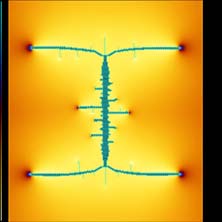If the elastic network is stressed we observe surface roughening, propagation of anticracks and mode I fractures.

Movies:
Prof. Björn Jamtveit, Department of Geology, University of Oslo



|
|
|
|
| We developed a new apparatus, the ElaPso-Meter to investigate patterns that form during dissolution-precipitation creep. We use photoelasticity to determine the local differential stress and the direction of the axis of the eigenvalues during insitu experiments of dissolution/precipitation. An example is shown on the right where one can see compressive stress concentrations on the right side of the hole at the tip of a horizontal fracture. Crystal is stressed vertically. |
|
Dr. Dag Dysthe, Department of Physics, University of Oslo |
|
|
The picture on the right hand side shows the optical setup to measure the photoelasticity or birefringence in the sample. |
|
That's it February 2002